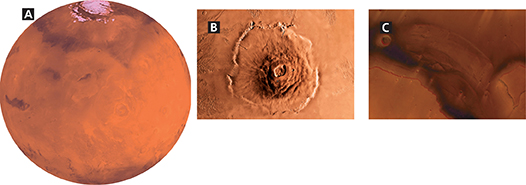Mars's Atmosphere
Mars has a very thin atmosphere, which allows astronomers to see its surface with a telescope. The thin Martian atmosphere and its distance from the sun make the surface very cold. Temperatures vary from − 140°C to 20°C. Mars's atmosphere is more than 95 percent carbon dioxide, similar to the atmosphere of Venus, but much thinner.
Water on Mars
 Mars shows evidence of once having a great deal of liquid surface water. Some geologists think Mars's northern lowlands were once covered by an ocean. Features shown in Figure 16C may have been stream channels and gullies. In fact, changes in surface features over the past several years indicate that water may still flow on the surface, if only for brief periods of time.
Mars shows evidence of once having a great deal of liquid surface water. Some geologists think Mars's northern lowlands were once covered by an ocean. Features shown in Figure 16C may have been stream channels and gullies. In fact, changes in surface features over the past several years indicate that water may still flow on the surface, if only for brief periods of time.
Why is liquid water rare on Mars's surface? Some water vapor has escaped into space. Some water is stored, along with frozen carbon dioxide, in ice caps at the north and south poles. Some water is frozen underground, just below the Martian surface.
Because Mars had large amounts of liquid water on its surface in the past, many scientists wonder if life once existed there. Robotic probes have carried out experiments on the Martian surface to look for signs of life. None of these probes found clear evidence for the existence of life on Mars.
Martian Seasons
Like Earth, Mars has distinct seasons. Mars's seasons are caused by the tilt of its axis. Over the course of a Martian year, Mars's ice caps grow and shrink. The change in seasons also causes large dust storms that occasionally rage across the surface.
Figure 16 Mars has a thin atmosphere that permits a clear view of its surface from space. A Mars has ice caps at both poles. BOlympus Mons is the largest volcano in the solar system. CThese Martian valleys are thought to have been formed at least in part by large flows of liquid water in the distant past.

Figure 17 This photo of a dark boulder on Martian sand was taken by the Mars Exploration Rover Spirit in 2006. Spirit found rocks and minerals that formed in, or were altered by, water.





